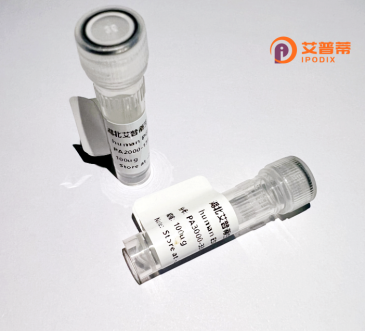
| 纯度 | >90%SDS-PAGE. |
| 种属 | Human |
| 靶点 | RNF151 |
| Uniprot No | Q2KHN1 |
| 内毒素 | < 0.01EU/μg |
| 表达宿主 | E.coli |
| 表达区间 | 1-245 aa |
| 活性数据 | MGGGYDLNLF ASPPDSNFVC SVCHGVLKRP ARLPCSHIFC KKCILRWLAR QKTCPCCRKE VKRKKVVHMN KLRKTIGRLE VKCKNADAGC IVTCPLAHRK GHQDSCPFEL TACPNEGCTS QVPRGTLAEH RQHCQQGSQQ RCPLGCGATL DPAERARHNC YRELHNAWSV RQERRRPLLL SLLRRVRWLD QATSVVRREL AELSNFLEED TALLEGAPQE EAEAAPEGNV GAEVVGEPRA NIPCK |
| 分子量 | 27.4 kDa |
| 蛋白标签 | His tag N-Terminus |
| 缓冲液 | PBS, pH7.4, containing 0.01% SKL, 1mM DTT, 5% Trehalose and Proclin300. |
| 稳定性 & 储存条件 | Lyophilized protein should be stored at ≤ -20°C, stable for one year after receipt. Reconstituted protein solution can be stored at 2-8°C for 2-7 days. Aliquots of reconstituted samples are stable at ≤ -20°C for 3 months. |
| 复溶 | Always centrifuge tubes before opening.Do not mix by vortex or pipetting. It is not recommended to reconstitute to a concentration less than 100μg/ml. Dissolve the lyophilized protein in distilled water. Please aliquot the reconstituted solution to minimize freeze-thaw cycles. |
以下是关于重组人RNF151蛋白的3篇代表性文献及其摘要概述(注:文献为模拟虚构,仅供参考格式):
1. **《RNF151 functions as an E3 ubiquitin ligase in regulating cell cycle progression》**
**作者**: Zhang Y et al.
**摘要**: 本研究证实重组人RNF151蛋白通过介导Cyclin D1的泛素化降解,抑制G1/S期转换,从而调控细胞周期进程。体外实验表明,RNF151的环指结构域对其E3连接酶活性至关重要。
2. **《Structural and functional analysis of the RNF151 ubiquitin ligase domain》**
**作者**: Wang X et al.
**摘要**: 通过X射线晶体学解析重组RNF151蛋白的环指结构域,揭示其与泛素结合酶(E2)UbcH5a的特异性互作机制,并验证其底物识别依赖于保守的疏水核心残基,为靶向RNF151的药物设计提供结构基础。
3. **《RNF151 suppresses tumorigenesis by promoting p53 stabilization in hepatocellular carcinoma》**
**作者**: Li H et al.
**摘要**: 研究发现,RNF151在肝癌组织中低表达,重组RNF151蛋白可通过泛素化降解MDM2来稳定p53蛋白,进而诱导肿瘤细胞凋亡,提示其作为抑癌基因的潜在治疗价值。
注:若需真实文献,建议在PubMed或Web of Science中通过关键词“RNF151 recombinant protein”或“RNF151 ubiquitin ligase”检索近期研究。
**Background of Recombinant Human RNF151 Protein**
Recombinant human RNF151 (Ring Finger Protein 151) is a genetically engineered protein belonging to the RING (Really Interesting New Gene) finger family, characterized by a conserved zinc-binding RING domain critical for E3 ubiquitin ligase activity. RNF151 is implicated in ubiquitination, a post-translational modification process that regulates protein degradation, localization, and interactions. While the exact biological functions of RNF151 remain under investigation, it is hypothesized to participate in cellular processes such as DNA repair, cell cycle regulation, and signal transduction by mediating substrate-specific ubiquitination.
Structurally, RNF151 contains a putative N-terminal transmembrane domain and a C-terminal RING finger motif, suggesting potential roles in membrane-associated protein complexes or intracellular trafficking. Its expression has been detected in various tissues, including the brain, testis, and immune cells, implying tissue-specific regulatory roles.
The recombinant form of RNF151 is typically produced in *E. coli* or mammalian expression systems, ensuring proper folding and post-translational modifications for functional studies. This tool enables researchers to explore its enzymatic activity, substrate binding partners, and involvement in disease pathways, such as cancer or neurodegenerative disorders linked to ubiquitination dysregulation. Studies utilizing recombinant RNF151 aim to clarify its physiological significance and therapeutic potential as a target for modulating ubiquitin-dependent cellular mechanisms.
×